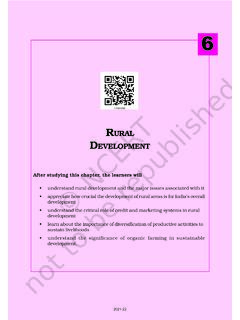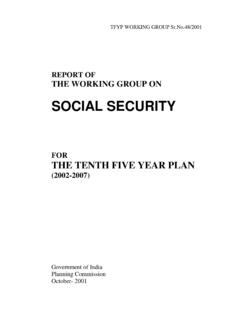Transcription of GOVERNMENT OF INDIA RECORD RETENTION SCHEDULE IN …
1 GOVERNMENT OF INDIA RECORD RETENTION SCHEDULE IN RESPECT OF RECORDS COMMON TO ALL MINISTRIES/ DEPARTMENTS 2012 DEPARTMENT OF ADMINISTRATIVE REFORMS & PUBLIC GRIEVANCES SARDAR PATEL BHAWAN, SANSAD MARG, NEW DELHI-110001 ii P R E F A C E The Department of Administrative Reforms and Public Grievances in the Ministry of Personnel, Public Grievances and Pensions, is entrusted with the responsibility of preparing RECORD RETENTION SCHEDULE common to all Ministries and Departments, so that there is uniformity in the RETENTION SCHEDULE of records of common nature in the area of policy, establishment and housekeeping created by the different Ministries/Departments of Central GOVERNMENT . With the assistance of a working group, having members from the Staff Inspection Unit of the Ministry of Finance, Ministry of Home Affairs and Comptroller and Auditor General, the first SCHEDULE was prepared and was circulated among the departments in January, 1963.
2 The last edition was brought out in 2004. This edition was arranged according to the Scheme of Functional File Index for facilitating recording of the files. With a view to bring economy of space, efficiency in retrieval of documents and coming into being of the Right to Information Act-2005 & the need for storage of electronic data/information, a need was felt to revise the RECORD RETENTION SCHEDULE . The Department of Administrative Reforms & Public Grievances had invited suggestions/comments from various Ministries/ Departments of GOVERNMENT of INDIA . The suggestions, thus, received and further inputs provided were considered by an Inter-departmental Committee headed by JS(O&M), DAR&PG and members from National Archives of INDIA , Department of Administrative Reforms & Public Grievances, Ministry of Culture, Department of Information Technology, National Informatics Centre and Department of Personnel.
3 I am glad to state that based on the recommendations of the Inter-departmental Committee, the Department of Administrative Reforms & Public Grievances is bringing out a revised edition of the RECORD RETENTION SCHEDULE . I hope this will go a long way in enabling the Central GOVERNMENT offices to properly operate their records management system. Any suggestions for improvement of this SCHEDULE will be welcome. ( Shri Sanjay Kothari ) Secretary, Department of Administrative Reforms & Public Grievances iii A C K N O W L E D G E M E N T RECORD Management has always remained a critical activity of the GOVERNMENT departments, as it is viewed as key to efficient administration. The Department of Administrative Reforms and Public Grievances is responsible for formulation of guidelines on RECORD Management and preparation of RECORD RETENTION SCHEDULE (RRS) for records common to all Ministries/Departments of GOVERNMENT of INDIA to ensure that there is uniformity in RETENTION SCHEDULE of records of common nature.
4 On formulation of the SCHEDULE , utmost care is taken to ensure that files are neither prematurely destroyed nor kept for period longer than necessary. The SCHEDULE is reviewed periodically. An inter-departmental Committee headed by the Joint Secretary (O&M), DAR&PG was constituted on comprising of members from the Ministry of Culture, Department of Electronics, Department of Personnel & Training, National Archives of INDIA , National Informatics Centre as also the Dir (O&M), Dir (AR), DS (e-Gov) and US (O&M) from DAR&PG to review the RECORD RETENTION SCHEDULE . The Terms of Reference (TOR) of the Committee comprised of (i) consideration of all basic policy issues relating to RRS with reference to suggestions received from various Ministries/Departments as well as to make other recommendations for Updation of RRS, (ii) examination of issues relating to preservations of records in electronic form with the perspective of e-Governance and (iii) prescribing RETENTION period for files relating to RTI cases.
5 Based on the recommendations of the Committee the revised RECORD RETENTION SCHEDULE (2012) was finalized on The members of the Committee took special interest to go through the details and it is on account of their commitment and dedication that the revised RRS could be finalized much before the prescribed target date of the Department s Results Framework Document (RFD) for the year 2012-13. The Department would like to place on RECORD special appreciation of Shri Arun Kumar Srivastava, Assistant Director (NAI) for his valuable suggestions on some important issues. The Department would also like to place on RECORD special appreciation for the invaluable contribution of Shri Arvind Suri-Dir, Shri Anurag Srivastava-US, Smt. Uma Sharma-SO, Smt. Neeru Verma-PS and Shri Sunil Kumar-DEO of O&M Division and Smt. Ritika Bhatia-Dir(AR) and Smt. Kavita Garg-DS( ) in the finalization of RECORD RETENTION SCHEDULE .
6 The Department of Administrative Reforms and Public Grievances would be grateful if the users of this publication send more suggestions for the improvement of the SCHEDULE . ( Shri Tiwari ) Joint Secretary, Department of Administrative Reforms & Public Grievances iv INSTRUCTIONS 1. The SCHEDULE follows the classification, arrangement and numbering scheme adopted for the functional file index for establishments and house-keeping work. 2. Categorisation of records have been done in accordance with Central Secretariat Manual of Office Procedure (CSMOP). Wherever necessary reference has been made to General Financial Rules (GFR) Appendix 13. Both GFR Appendix 13 and CSMOP Appendix 28 have been incorporated as annexures. 3. Those items of the functional file index, for which it has not been possible to prescribe rigid RETENTION periods, have been omitted from this SCHEDULE .
7 4. Where necessary, additional main heads and sub-heads have been opened under the appropriate group headings and main heads respectively. 5. RETENTION periods for records (other than files) registers, for which no files are to be opened and which, therefore, are not covered by the functional file index, have been shown under the appropriate group headings at the end. 6. RETENTION periods for records common to all departments, but not relating to establishment and house-keeping work, and therefore not covered by the functional file index, have been shown at the end of the SCHEDULE . 7. Unless otherwise stated the records described in column 2 of the SCHEDULE refer to files. Where necessary, other ancillary records pertaining to such files like mortgage deeds or bonds, nomination form, etc. would have to be retained as specifically indicated in column 4 against the relevant items.
8 8. The RETENTION period specified in column 3, in the case of a file, is to be reckoned from the year in which the file is closed ( action thereon has been completed) and not necessarily from the year in which it is recorded. 9. In the case of records other than files, for example, registers, the prescribed RETENTION period will be counted from the date on which it has ceased to be current. 10. If a RECORD relates to two or more subjects for which different RETENTION periods have been prescribed, it will be retained for the highest of such periods. 11. In exceptional cases, if the RECORD has certain special features or such a course is warranted by the peculiar needs of the department, the RECORD may be retained for a period longer than that specified in the SCHEDULE , in no case, however, will a RECORD be retained for a period shorter than that prescribed in the SCHEDULE .
9 V 12. If a RECORD is required in connection with the disposal of another RECORD , the former will not be weeded out until after all the issues raised on the latter have been finally decided, even though the RETENTION period marked on the former may have expired in the meantime. In fact, the RETENTION periods initially marked on such records should be consciously reviewed and, where necessary, revised suitably. 13. The individual Ministries/Departments are requested to ensure that the provisions contained in the RECORD RETENTION SCHEDULE are strictly followed. NOTE:- Department means any of the ministries, departments, secretariat and offices mentioned in the First SCHEDULE to the GOVERNMENT of INDIA (Allocation of Business) Rules. vi TABLE OF CONTENTS PART I - Records relating to establishment and house-keeping work Page/Pages A Establishment 1-19 B - Welfare 20-24 C - Vigilance 25-31 D - Common Office Services 32-46 E - Hindi 47-49 F - Public relations 50-53 G - Finance, budget cash and accounts 54-65 H - Parliament 66-68 I - RECORD RETENTION SCHEDULE of files relating to RTI application 69 J - Electronic Records 70-72 PART II - Records (other than those relating to establishment and housekeeping work) common to all departments 73-77 Annex I General Financial Rules (GFR) Appendix 13 78-87 Annex - II Central Secretariat Manual of Office Procedure (CSMOP) Appendix - 28 88-91 vii Categorization of Records Physical Records* - File may be recorded under any one of the following category.
10 (1) Category 'A' meaning 'keep and microfilm' - (a) files which qualify for permanent preservation for administrative purposes and which have to be microfilmed because they contain: (i) a document so precious that its original must be preserved intact and access to it in the original form must be restricted to the barest minimum to avoid its damage or loss; or (ii) material likely to be required for frequent reference by different parties simultaneously/frequently. (b) files of historical importance. (2) Category `B' meaning `keep but do not microfilm'-This category will cover files required for permanent preservation for administrative purpose. It will, however, exclude the nature of material falling under the category described in (i) or (ii) of sub-para (1) (a) above and therefore need not be microfilmed. (3) Category `C' meaning `keep for specified period only'. This category will include files of secondary importance having reference value for a limited period not exceeding 10 years.




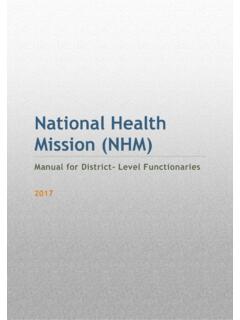
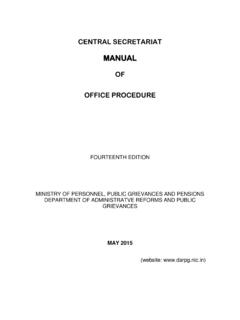

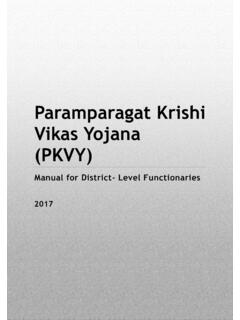




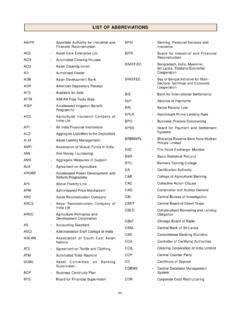

![Insurance Law Regulations in India [ ] [ ][ ][ ]](/cache/preview/7/1/b/4/9/6/e/e/thumb-71b496ee4a80dc2146cbc953fd15151a.jpg)
